
งานเสวนา “เปลี่ยนขยะเป็นทอง” (TH/EN)
[For English, please scroll down.]
จากการต่อยอดจากนิทรรศการ “Pure Gold – Upcycled! Upgraded! เปลี่ยนขยะเป็นทอง” ได้เกิดเป็นกิจกรรมเสวนา “เปลี่ยนขยะเป็นทอง” ที่ผ่านมา โดยกิจกรรมนี้เป็นส่วนหนึ่งในการสร้างโอกาสในการนำขยะและเศษวัสดุเหลือใช้มาสร้างมูลค่าใหม่ (upcycling) ทั้งในแง่มุมคุณค่าและบริบทของวัสดุพื้นถิ่นและกระบวนการในการนำมาใช้ พร้อมทั้งเทรนด์ของการสร้างมูลค่าจากเศษวัสดุในประเทศไทยให้แก่ผู้คนทั่วไป จัดขึ้นเมื่อวันที่ 14 กรกฎาคม 2561 เวลา 14:00 – 15:30 น. ณ ห้อง Material Design and Innovation Center TCDC กรุงเทพฯ
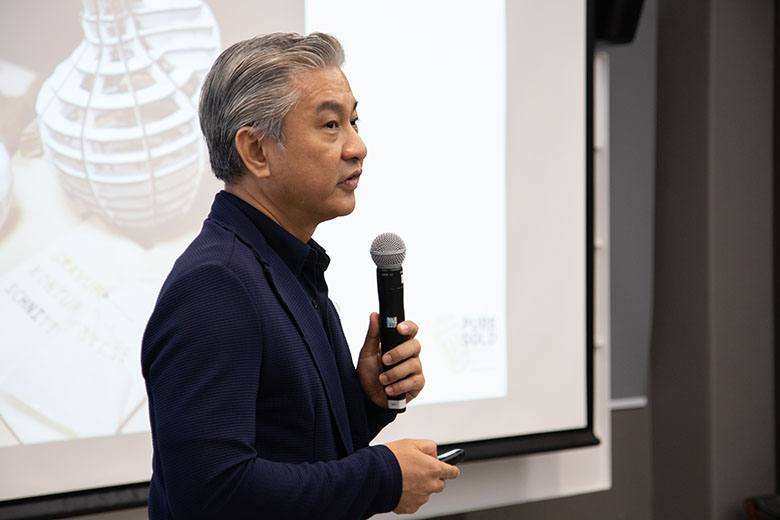
คุณเอกรัตน์ วงษ์จริต ผู้ดำเนินรายการ
โดยได้เรียนเชิญดีไซน์เนอร์ไทยส่วนหนึ่งที่ได้ร่วมกับนิทรรศการและทำงานที่เกียวข้องกับการสร้างมูลค่าใหม่ให้เศษวัสดุมาร่วมแบ่งปันความรู้ ประกอบไปด้วย คุณเอกรัตน์ วงษ์จริต ภัณฑารักษ์ภาคเอเชียตะวันออกเฉียงใต้ในนิทรรศการ “Pure Gold – Upcycled! Upgraded! เปลี่ยนขยะเป็นทอง” เป็นผู้ดำเนินรายการร่วมกับ 3 วิทยากร คุณรุ่งทิพย์ ลุยเลา นักออกแบบเจ้าของผลงาน The Biodegradable Functional Tableware คุณจารุพัชร อาชวะสมิต นักออกแบบเจ้าของผลงาน Horse Hair Collection ดีไซน์เนอร์รับเชิญ (Local Designer) สำหรับการสัญจรมาที่ประเทศไทยของนิทรรศการ รวมไปถึงคุณศรุตา เกียรติภาคภูมิ นักออกแบบเจ้าของผลงาน Paan ที่นำเศษเหล็กมาอัปเกรดให้กลายเป็นงานศิลปะ ชิ้นงานซึ่งร่วมสัญจรไปกับโครงการ Pure Gold
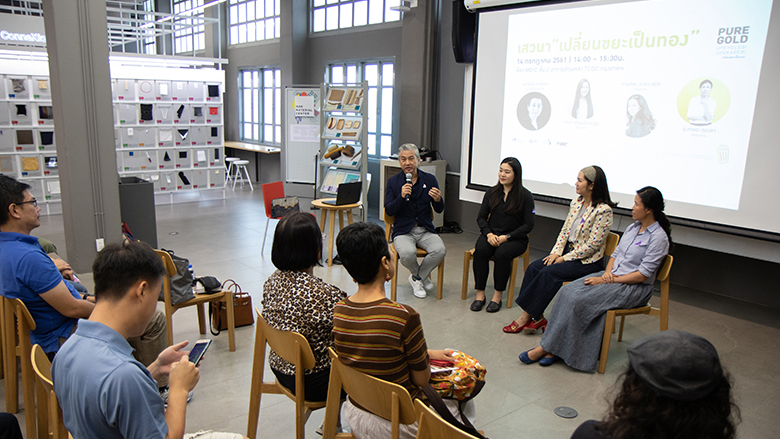
นิทรรศการว่าด้วยเรื่องการสร้างมูลค่าให้เศษวัสดุ
คุณเอกรัตน์ วงษ์จริต เริ่มต้นด้วยการเล่าถึงที่มาที่ไปของการสร้างมูลค่าให้เศษวัสดุ ร่วมกับสถาบันเกอเธ่และสถาบัน ifa (Institut für Auslandsbeziehungen) ออกมาเป็นโปรเจกต์เพื่อสร้างพื้นที่ในการแลกเปลี่ยน เรียนรู้ ในรูปแบบของ การประชุมเชิงปฏิบัติการ การประชุมร่วมของผู้แทนองค์กรต่างๆ และนิทรรศการ โดยได้เล่าถึงประสบการณ์จากกิจกรรมที่คัดเลือกผลงานของศิลปินทั่วโลกมาร่วมเสวนาที่ประเทศเยอรมนี ซึ่งงานดังกล่าวมีผู้เข้าร่วมสัมมนาราว 200 คน เนื่องจากประเทศเยอรมนีเป็นต้นแบบของการทำอุตสาหกรรมหนักของโลก และนี่เป็นครั้งแรกที่มีการจัดงานเกี่ยวกับการจัดการขยะอย่างจริงจัง โดยทุกฝ่ายพยายามหาหนทางที่ยั่งยืนตั้งแต่ต้นทางจนถึงปลายทาง อย่างรถแฟบโมบิล หน่วยเคลื่อนที่ที่มีจุดประสงค์ในการสนับสนุนชุมชนในเยอรมนี โดยใครที่มีไอเดียก็สามารถมาพูดคุยกับผู้เชี่ยวชาญ ทดลองผลิตสิ่งที่คิดออกมาเป็นวัตถุที่จับต้องได้จริง ด้วยเครื่องพิมพ์ 3 มิติเปิดโอกาสให้คนทั่วไปที่ไม่ได้โอกาสได้มาแสดงความคิดสร้างสรรค์ของตัวเอง สร้างคุณค่าให้แก่วัสดุและผู้คนไปพร้อมๆ กัน
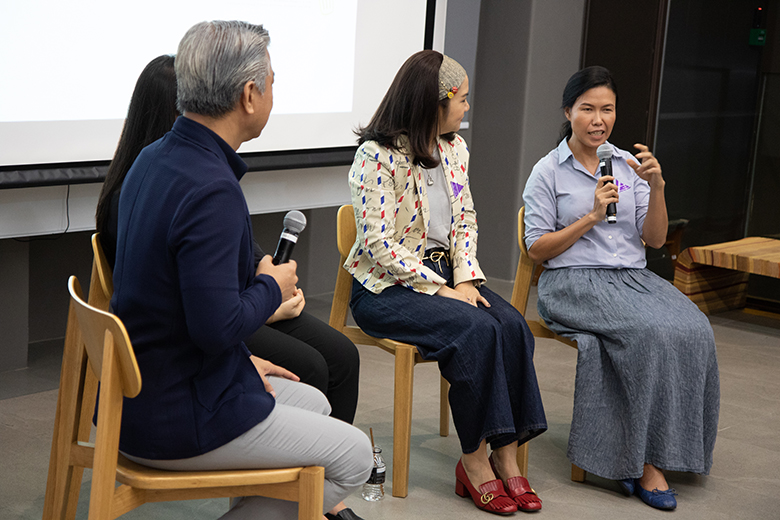
ในส่วนของประเทศไทย แม้เราจะมีรายได้จากการนำขยะมาสร้างมูลค่าใหม่เป็นจำนวนมากในแต่ละปี โดยใช้งานหัตถกรรมเป็นตัวช่วยสร้างสรรค์ แต่ปัจจุบันก็ยังคงเหลือขยะอีกเป็นจำนวนมาก ซึ่งคุณเอกรัตน์ให้ความเห็นว่าผู้ประกอบการจำเป็นที่จะต้องมีส่วนร่วมในการลดปริมาณขยะตั้งแต่ต้นทาง หรือใช้นวัตกรรมใหม่ๆ เทคโนโลยีใหม่ๆ สร้างผลิตภัณฑ์ที่สามารถนำกลับมาใช้ซ้ำได้ โดยคาดการณ์ว่าภายใน 10 ปีข้างหน้า มนุษยชาติจะไม่มีวัสดุใดที่ผลิตจากทรัพยากรที่บริสุทธิ์อีกต่อไป แต่วัสดุต่างๆ จะถูกผสมปะปนด้วยวัสดุเก่าทั้งหมด โดยนอกจากแนวคิดด้านการผลิต การสร้างสรรค์ ยังมีมุมมองด้านความทนทานของชิ้นงานที่ยังต้องคำนึงถึงอีกด้วย
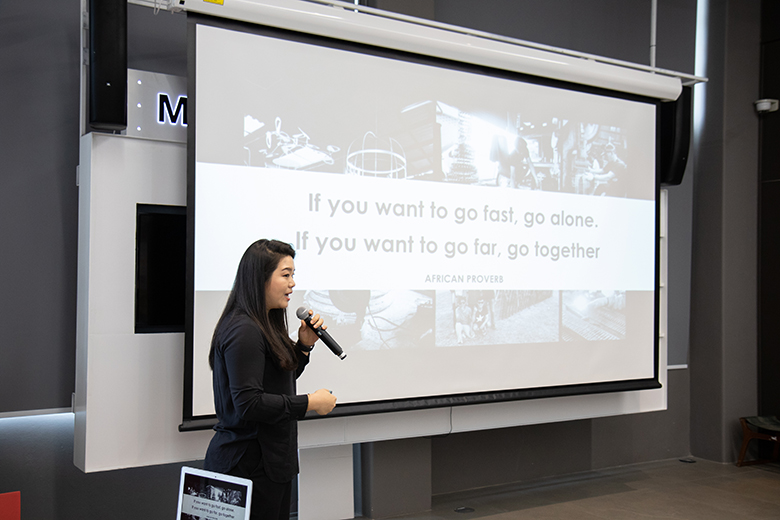
คุณศรุตา เกียรติภาคภูมิ
ชุบชีวิตเศษเหล็กพร้อมสร้างชีวิตชีวาให้คนทำงาน
คุณศรุตา เกียรติภาคภูมิ เล่าให้ผู้เข้าร่วมงานฟังถึงบรรยากาศภายในโรงงานของครอบครัวเธอเอง ซึ่งเป็นโรงงานผลิตลูกล้อ กรอบอะลูมิเนียม และบานประตู เธอสังเกตเห็นว่าโรงงานที่เธอเกิดและเติบโตมาใช้คนราว 60 คนในการทำลูกล้อ 1 ตัว เธอตั้งคำถามว่าทำไมจึงใช้เวลาในการทำงานนานขนาดนั้น จากการปฏิเสธกิจการที่บ้าน เธอเริ่มกลับมามองอุตสาหกรรมโลหะเหล่านี้ในมุมมองใหม่ และทดลองนำเศษที่เหลือจากการผลิตชิ้นส่วนต่างๆ มาออกแบบ สร้างสรรค์เป็นโคมไฟ งานศิลปะจัดวางต่างๆ ภายใต้แนวคิด ‘The Reincarnation of Waste’ ชุบชีวิตเศษเหล็กและคนที่ทำงานกับเราไปด้วยกัน โดยมุ่งไปที่การนำวัสดุเหลือทิ้งกลับมาใช้ใหม่ สร้างคุณค่าและมูลค่าให้มากขึ้นผ่านการออกแบบเฉพาะสำหรับลูกค้าแต่ละราย และเน้นความประณีตบรรจงของงานฝีมือ คุณศรุตาเล่าว่า เธอพิถีพิถันในการเลือกลายที่เหมาะสมจริงๆ มาใช้ สังเกตวงจรชีวิตของเหล็กประเภทต่างๆ ว่าจะเกิดขึ้นเมื่อใด จึงคำนวณได้ว่าชิ้นส่วนที่ต้องการจะเกิดขึ้นเมื่อไหร่ เธอได้รับคัดเลือกจากกรมส่งเสริมการส่งออก ได้รับการสนับสนุนสำหรับพัฒนาการทำงาน จากงานชิ้นเล็กๆ จึงขยับขยายขนาดให้เข้าไปอยู่ในสเปซมากขึ้น จากผลิตภัณฑ์ขยายเป็นงานจัดแสดงในพื้นที่และกลายเป็นโปรเจ็กต์ธอยกตัวอย่างผลงานจัดแสดงในล็อบบี้ของ IR-ON Hotel (2017) ซึ่งเป็นชิ้นงานที่จัดทำขึ้นพิเศษสำหรับสถานที่นี้เท่านั้น

นอกจากนี้คุณศรุตาได้ทดลองเพิ่มเติมวัสดุต่างๆ อีกหลายประเภททั้งแผ่นอะคริลิก แก้ว และการสร้างแพทเทิร์นลายต่างๆ ผลงานของเธอกระจายไปตามสถานที่ต่างๆ เช่น ร้านอาหารในช่างชุ่ย Wonderfruit W District วัดป่าวิเวก (ธรรมชาน์) ที่อุบลราชธานี การเปิดรับงานที่สเกลใหญ่ขึ้นเรื่อยๆ จึงต้องเรียนรู้เกี่ยวกับโครงสร้าง เพิ่มองค์ความรู้ด้านวิศวกรรมมากขึ้น ในฐานะนักออกแบบที่ไม่ได้เป็นผู้ติดตั้งผลงานเองจึงต้องวางแผนให้การขนย้าย การออกแบบงานให้ไปถึงที่หมายอย่างปลอดภัย และติดตั้งได้ถูกต้องเมื่อถึงหน้างาน จึงต้องออกแบบวิธีการสื่อสารให้ช่างสามารถทำได้ตามสเป็กที่ต้องการและต้องพร้อมรับการแก้ไขปัญหาเฉพาะหน้าตลอดเวลา
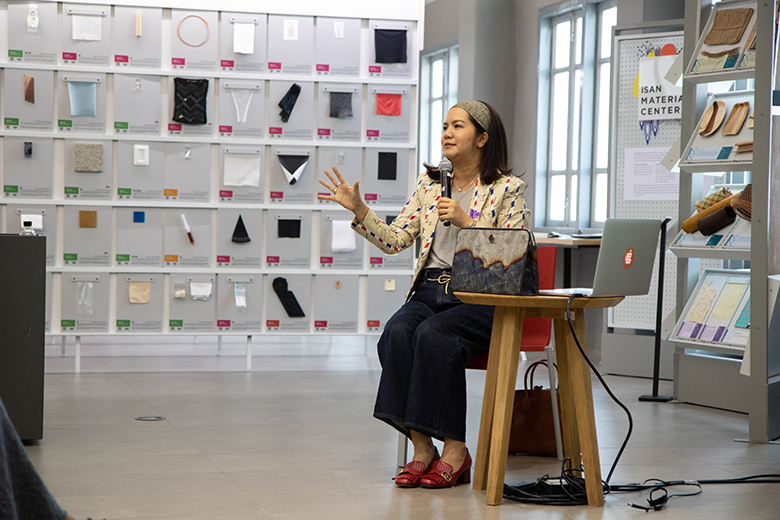
คุณจารุพัชร อาชวะสมิต
เข้าใจวัสดุอย่างละเอียด และมองหาข้อดีให้เจอ
คุณจารุพัชร อาชวะสมิต เริ่มต้นเล่าในฐานะนักออกแบบผ้า เนื่องจากประสบการณ์ในวัยเด็กที่เคยได้ใช้กล้องจุลทรรศน์ของคุณแม่ผู้เป็นนักวิทยาศาสตร์ในกรมวิชาการการเกษตร เธอจึงได้มีโอกาสเห็นโครงสร้างของเนื้อผ้าอย่างใกล้ชิด เป็นจุดเริ่มต้นให้สนใจเรื่องคาแรกเตอร์ของวัสดุนับแต่นั้นเป็นต้นมา แม้จะเป็นนักออกแบบผ้า หลงใหลความงามของโครงสร้างสิ่งทอ แต่เธอไม่เคยจำกัดตัวเองอยู่เพียงฝ้าย หรือไหมเท่านั้น คุณจารุพัตรมองว่า โลหะคือต้นกำเนิดของการรีไซเคิล จึงทดลองนำงานโลหะมาตกแต่งภายในอาคาร ภายนอกอาคาร สร้างงานออกแบบโดยใช้เทคนิคการทอเหมือนผืนผ้า โดยหยิบเอาจุดเด่นการเกิดคราบสนิมสีต่างๆ ของโลหะมาใช้ในงานออกแบบ ด้วยการนำเศษโลหะเหลือทิ้งมาแปรรูปเป็นเส้น แม้จะมุ่งนำเสนอกลุ่มตลาดลักซ์ชัวรี่ แต่ด้วยความเชื่อมั่นในแนวทางการออกแบบ จึงไม่ผิดที่จะสร้างผลงานหรูหราจากขยะที่คนไม่ต้องการ เธอมองว่าตัวเองเป็นผู้ออกแบบวัสดุ มองทุกอย่างเป็นธาตุ นำเทคโนโลยีต่างๆ มาทดลองใช้เคลือบวัสดุต่างๆ ด้วยกระแสไฟฟ้า ซึ่งเคลือบได้หลายความหนา เปลี่ยนวัสดุเดิมๆ ที่เปราะหักง่ายให้กลายเป็นวัสดุที่แข็งแรงมากพอจะทำเป็นเฟอร์นิเจอร์ได้ หรือใช้เครื่องฮีททรานเฟอร์นำความร้อนมาเปลี่ยนรูปร่างวัสดุ สิ่งสำคัญคือการทำความเข้าใจวัสดุแต่ละชนิดอย่างละเอียด ผ่านการมองหาข้อดีข้อเสียของมันให้เจอ โดยคุณจารุพัชร ทิ้งท้ายว่า “ในอนาคต ทรัพยากรจะเหลือน้อยเกินกว่าที่เราจะใช้มันอย่างสิ้นเปลืองเช่นในทุกวันนี้ได้ ตอนนี้เราจึงต้องมองทุกอย่างเป็นทอง ทุกอย่างมีค่า ถ้าเราเริ่มมองแบบนั้น เราก็จะใช้ชีวิตอย่างมีระบบ มีสติมากขึ้น”

คุณรุ่งทิพย์ ลุยเลา
โจทย์ใหม่ของการออกแบบ ‘เมื่อขยะเป็นวัสดุตั้งต้นในการทำงาน’
คุณรุ่งทิพย์ ลุยเลา เล่าว่ามหาวิทยาลัยเกษตรศาสตร์มีความมุ่งมั่นในการศึกษาความเป็นไปได้ในการนำกระบวนการในระบบอุตสาหกรรมหรือองค์ความรู้จากชุมชนมาพัฒนาการจัดการขยะ เนื่องจากในปัจจุบันเรายังไม่สามารถคิดได้ครบรอบด้านมากพอ นักออกแบบยังติดกับดักของความสวยงาม ปัญหาที่พบในการผลิตสินค้าต่างๆ ในปัจจุบันคือมักมีของเหลือทิ้งเสมอ คิดเป็นจำนวนถึง 30% ของวัสดุทั้งหมดที่ใช้งานเป็นอย่างน้อย Scrap Design คือการหาองค์ความรู้ในการคิดค้นหาวิธีลดการใช้วัสดุตั้งแต่ต้นทาง คุณรุ่งทิพย์กล่าวว่า “คนที่ทำงานเป็นนักออกแบบก่อปัญหามหาศาล หยิบออกมาแต่ของสวยๆ ทิ้งของไม่สวยไว้เบื้องหลังเสมอ” เพราะเครื่องจักรอุตสาหกรรมขนาดใหญ่แก้ปัญหาเศษวัสดุชิ้นเล็กๆ ไม่ได้ และในขณะเดียวกันพื้นที่สำหรับทิ้งขยะไม่พออีกต่อไป หากฝังก็จะเกิดปัญหาใต้ดิน หากเผาก็จะเกิดปัญหาในอากาศ ไม่ว่าจะอุตสาหกรรมใดก็ตาม งานคราฟต์เองแม้จะเป็นงานฝีมือที่ดูเป็นมิตรต่อโลก แต่ก็สร้างปัญหาขยะเหลือทิ้งได้เช่นเดียวกัน เนื่องจากผู้ผลิตมักต้องเผื่อวัสดุไว้ หรือผลิตเผื่อสำหรับตอบรับความต้องการของผู้ซื้อ ทำให้มีของเหลือค้างสต๊อก ทั้งวัตถุดิบและผลิตภัณฑ์ขายไม่ได้

โจทย์ใหม่ของการออกแบบจึงเป็นการไม่ออกแบบของสวยแต่เป็นงานออกแบบที่แก้ปัญหาได้จริง คนในทีมเริ่มมองว่าจะสร้างอะไร อย่างไร ทุกอย่างสามารถนำมาออกแบบได้ เพียงเปลี่ยนวิธีการคิด มองมุมใหม่ เปลี่ยนจากของที่กลายเป็นขยะให้กลายเป็นวัสดุตั้งต้นในการทำงาน วิธีการออกแบบของทีมจึงเป็นการแก้ปัญหาด้วยการออกแบบ
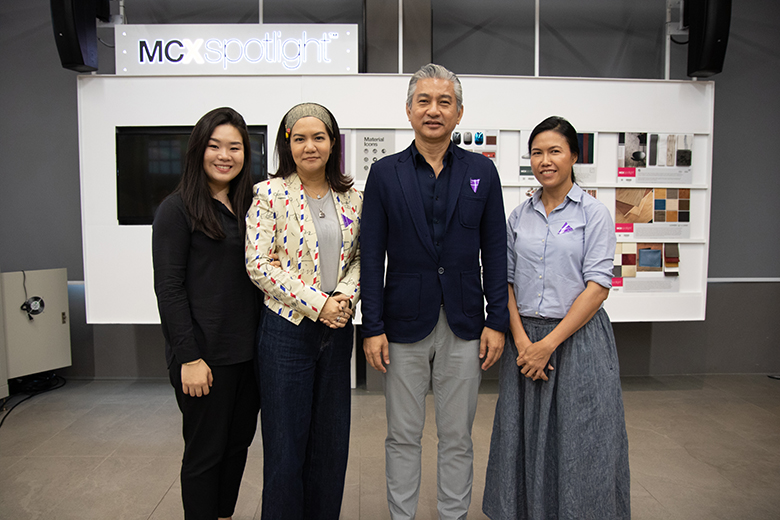
Upcycling Product หรือการสร้างคุณค่าให้วัสดุเหลือทิ้งนั้นเราต้องสร้างคุณค่าให้ได้ ซึ่งจะเกิดขึ้นก็ต่อเมื่อสร้างรายได้ให้ชาวบ้านได้จริง การมองไปถึงการแก้ปัญหาเรื่องขยะจึงไม่ใช่แค่เมื่อมีขยะจะนำมาทำอะไร แต่ต้องคิดถึงตั้งแต่การลดปริมาณขยะตั้งแต่ต้น สร้างกระบวนการผลิตที่เป็นมิตรต่อสิ่งแวดล้อม ผลิตของคุณภาพดีมีอายุยืนยาว แข็งแรงทนทาน ไม่กลับไปเป็นขยะอีกครั้ง ยกตัวอย่างเช่น การนำชุดยูนิฟอร์มเก่าของพนักงานธนาคารมาเปลี่ยนเป็นที่หุ้มโซฟาในธนาคารแทน หรือนำเศษผ้ายีนส์ขนาดเล็กมากมาทอเป็นผืนผ้าใหม่ หรือป้ายติดเสื้อผ้านำไปทอใหม่ให้ชุมชนนำไปจำหน่ายได้ แม้แต่ขยะที่กำจัดได้ยากอย่างเปลือกผลไม้ ก็ต้องเริ่มตั้งแต่การคิดวางแผนหาวิธีการปอกแบบใหม่ๆ ที่นำไปใช้ต่อได้ดีขึ้น แกงที่กินเหลือก็นำมาลองย้อมผ้าได้ ใช้ทรัพยากรที่มีอยู่ให้เกิดประโยชน์สูงสุด ใช้อย่างคุ้มคุณค่าที่สุด
กิจกรรมเสวนา “เปลี่ยนขยะเป็นทอง” เป็นกิจกรรมประกอบนิทรรศการ “Pure Gold - Upcycled! Upgraded! เปลี่ยนขยะเป็นทอง” นิทรรศการสัญจรจากประเทศเยอรมนี ที่ชวนทุกคนสำรวจและจัดแสดงแนวทางการนำขยะและเศษวัสดุมาสร้างมูลค่าใหม่ ผ่านผลงานออกแบบของดีไซเนอร์หลากหลายสาขาจากทั่วโลก จัดขึ้นระหว่างวันที่ 18 พฤษภาคมถึงวันที่ 22 กรกฎาคม 2561 ณ ห้องแกลอรี่ ชั้น 1 อาคารส่วนหลัง TCDC กรุงเทพฯ
“Pure Gold – From Waste to Gold” talk
As an addition to the “Pure Gold - Upcycled! Upgraded!” exhibition, a talk was held to promote and explore the concept of unravelling the opportunities for upcycling trash and waste materials to create new values, held on the 14 July 2018 from 14:00 – 15:30 at TCDC’s Material Design and Innovation Center. The discussion also addressed the value and context of local materials, the utilization process and the trend of creating value from waste materials in Thailand.
Where some of the Thai designers involved in the exhibition and are engaged in working relating to ‘upcycling’ were invited to share their experience. This includes Eggarat Wongcharit, Southeast Asia curator for the exhibition “Pure Gold - Upcycled! Upgraded!” hosted the talk along with 3 speakers who presented their own upcycling approaches for the Thailand stop of the travelling exhibit. The 3 local designers are Rungthip Luilao who upgraded fruit waste into the Biodegradable Functional Tableware, Jarupatcha Achavasmit who designed the Horse Hair Collection from rejected safety belts and Saruta Kiatparkpoom who transformed metal scrap into Paan, which will travel with Pure Gold project.
An Exhibition on Creating Value out of Scrap Materials
Eggarat Wongcharit began by giving the background on his upcycling collaboration with the Goethe-Institut and ifa (Institut für Auslandsbeziehungen), resulted in a project that created space for knowledge exchange, workshops, meetings with representatives from various organizations and exhibitions. He shared his experience participating in the international conference held to select about 200 artists from around the world to join the talk in Germany. As Germany is the world’s role model of heavy industries, that was the first time a concerted effort on trash management took place. Every sector tried to find sustainable cradle-to-grave solutions such as FABMOBIL, a moving unit designed to promote communities in Germany. It allows anyone to consult with experts and experiment their design with 3D Printer to turn into tangible work. FABMOBIL gives those that are unfamiliar an opportunity to show their creativity whist creating value for materials and people at the same time.
In Thailand, even though we generate high income from upcycling trash with craftsmanship each year, there is still a great deal of trash left. Eggarat suggested that entrepreneurs must take part in reducing trash from its origin or use new innovations and technologies to create reusable products, with the prediction that in the next 10 years, humankind will barely have any raw materials from natural resources. Instead, there will only be a mixture of old materials. Besides the production and creative process, we must therefore consider the durability aspect as well
Reviving Metal Waste and Enlivening the Workers
Saruta Kiatparkpoom talked about the atmosphere in her family’s factory, which produces casters, aluminum frames and door frames. Having noticed that the factory, where she was raised in needed 60 workers to make 1 caster, she wondered why it took so long. From rejecting her family business, she started looking at the metal industry in a new light. Saruta then experimented on using manufacturing waste to design lamps and other installation arts under ‘The Reincarnation of Waste’ concept to revive metal waste and workers at the same time. She focused on reusing surplus materials to add value with custom design for each customer and fine craftsmanship. Saruta said that she carefully selects only the appropriate pattern and observes the life cycle of each kind of steel to calculate when the desired part will come along. Thanks to her outstanding work, Saruta has been selected by the Department of Export Promotion to receive their development support. From her smaller products, her designs have also expanded to larger-scale installations and projects. An example of her work is the site-specific installation art in the lobby of IR-ON Hotel (2017).
Moreover, various other materials: from acrylic and glass was experimented further to creating different patterns by Saruta. Where her designs can be found in various places such as a restaurant in ChangChui, Wonderfruit Festival, W District, and Vivek Forest Monastery (Dhammacha) in Ubon Ratchathani. As she takes on larger-scale works, she had to learn about structure and more engineering know-how and as a designer who doesn’t carry out the installation process herself, Saruta must plan the logistics ahead so that her work can be safely delivered and correctly installed at the site. She also needs to design an effective communicating system with the craftspeople to achieve the desired specifications while always be ready to solve unexpected problems.
Understanding the Materials and Finding Their Strengths
Jarupatcha Achavasmit began by sharing her story as a fabric designer. From her childhood experience using her mother’s microscope (her mother was a scientist at the Department of Agriculture), she had the chance to see fabric structure upclose. That was the beginning of her interest in the material’s character. Even though Jarupatcha is a fabric designer who falls in love with the beauty of fabric structure, she never limits herself to only cotton or silk. Seeing that metal is the origin of recycling, she experiments with using metal work for both interior and exterior decorations, creating new designs with fabric weaving techniques. Using the different shades of rust created by metal oxidation and reprocessing scrap metal into strips. Even though Jarupatcha targets the luxury market, she has confidence in her design approach that it is not wrong to create luxurious products from unwanted trash. She sees herself as a material designer. For her, everything is an element. Jarupatcha has used technologies to experiment on coating different materials with electric current that can give various level of thickness, this technique can turn fragile materials into something strong enough for making furniture, or the use of heat transfer technique can also apply to change the form of material. The key is to deeply understand each material thoroughly through identifying its pros and cons. Jarupatcha concluded that, “In the future, resource will be too scarce for us to use it wastefully like today. Now we must look at everything like it is gold. Everything is valuable. If we start look at it this way, we will spend our life more systematically and more mindfully.”
The New Design Challenge: When Trash Becomes Raw Material
Rungthip Luilao shared that Kasetsart University is determined to study the possibility in adapting industrial processes or community knowledge to develop trash management solutions. Since we are still unable to view the holistic approach and designers are still caught in the aesthetic trap, the problem we are facing is manufacturing processes produce wasted surplus materials that account for at least 30% of total used materials. Scrap Design is the development of knowledge to find out how to reduce material usage from the initial source. Rungthip said that, “Many designers cause massive problems, some picks out only the attractive things and leave the unattractive things behind.” Since, large-scale industrial machines can’t solve the problem from small-sized scrap materials. Meanwhile, there are no longer enough trash sites, by burying it would contaminate the ground and burning it would pollute the air, regardless of industry. Even the seemingly eco-friendly craftworks also cause waste problems as well since producers tend to stock spare materials or over-produce to meet the demand of buyers. That leads to an overstocking of materials and products that remain unsold
The new design challenge is therefore to design not an attractive product but something that can truly solve problems. Her team members started thinking about what to build and how. Everything is designable, when adjust the way of thinking and look at the new angles; trash can turn into raw material. The design method was therefore to solve problems with design.
Upcycling products mean we must create value. That can be shown when actual income for the villagers is achieved. Solving trash problems involves not only what to do when we have trash, but we must find a way to reduce waste from the beginning, design new eco-friendly manufacturing process, produce good quality products that are long-life, strong and durable so that they will not become trash again. For example, using old staff uniforms as sofa upholstery at the bank, weaving small denim scraps into new fabric or reweaving clothing labels so that the community can sell them. Even with fruit skins that are hard to dispose, we must begin thinking about new and better peeling methods. We can try using leftover curries dye fabric. Just use our existing resources for maximum benefit and value.
“Pure Gold – From Waste to Gold” talk is an extension event of the “Pure Gold – Upcycled! Upgraded!” an international touring exhibition from Germany, which invites everyone to explore and present approaches to creating valuable products out of trash and waste materials via the works of designers from diverse fields around the world. The exhibition was held from 18 May – 22 July 2018 at the Gallery, 1 Fl., Back Building, TCDC Bangkok.




